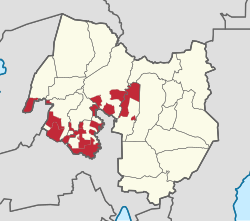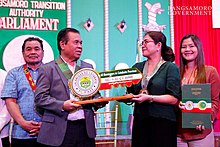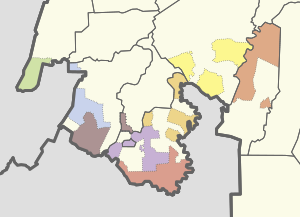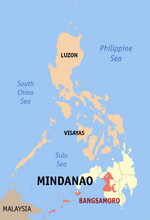Special Geographic Area
 From Wikipedia - Reading time: 12 min
From Wikipedia - Reading time: 12 min
Special Geographic Area
Ligawasan Province[1] | |
|---|---|
 A barangay hall in Gli-Gli in Ligawasan | |
 Territory in Cotabato province under the Special Geographic Area | |
| Country | |
| Region | |
| Province | Cotabato (geographically only) |
| Municipalities | |
| Barangays | 63 |
| Plebiscite of Cotabato barangays to join Bangsamoro | February 6, 2019 |
| Foundation date | February 14, 2019[2][3] |
| Turnover to Bangsamoro | November 20, 2019 |
| Municipality creation plebicites | April 13, 2024 |
| Government | |
| • Body | Special Geographic Area Development Authority[4] |
| • Administrator | Butch Panigel Malang |
| Area | |
• Total | 824.311 km2 (318.268 sq mi) |
| Population (2020 census)[5] | |
• Total | 215,433 |
| • Density | 260/km2 (680/sq mi) |
The Special Geographic Area (SGA) is a loose collection of 63 barangays in six municipalities of the province of Cotabato in the Philippines. It is part of the Bangsamoro Autonomous Region in Muslim Mindanao, despite the province of Cotabato itself being part of a separate neighboring region, Soccsksargen.
These barangays were partitioned from Soccsksargen following a two-part plebiscite held in January and February 2019 that formed Bangsamoro after residents of said barangays consented to their localities' inclusion in the new autonomous region. The municipalities these barangays are a part of, as well as the barangays themselves, remain part of Cotabato. These barangays could be reorganized into one or more new municipalities or merged with any of the neighboring municipalities in Maguindanao del Norte and Maguindanao del Sur, which are part of Bangsamoro.
The Bangsamoro regional government started effective governance over these barangays since the official turnover of these localities to the region by the Cotabato provincial government on November 20, 2019.
Some of these barangays are exclaves, which means they are entirely surrounded by localities that are not part of Bangsamoro.
History
[edit]
2019 Bangsamoro creation plebiscite
[edit]The Philippine government organized a two-part plebiscite that concerns the ratification of the Bangsamoro Organic Law, the founding basis of the then-to-be established Bangsamoro Autonomous Region in Muslim Mindanao (BARMM), which was intended to replace the Autonomous Region in Muslim Mindanao (ARMM), and the expansion of the then-proposed Bangsamoro autonomous region to potentially include municipalities in Lanao del Norte, the cities of Isabela in Basilan and Cotabato in Maguindanao, and select barangays in Cotabato province. For the prospective barangays in Cotabato to join, voters in all of the parent municipalities also had to consent to their bid to join Bangsamoro.
Out of 67 barangays in Cotabato that were included in the plebiscite, 63 had successful bids for their inclusion in the Bangsamoro autonomous region.[6] The four that rejected the measure are Galidan in Tulunan, Balatican in Pikit, and Pagangan and Lower Mingading in Aleosan; these four were excluded from BARMM and remained part of Soccsksargen. Meanwhile, each municipality consented to its barangays joining the BARMM. In Pikit, the most populous municipality in Cotabato, all but one barangay that voted in the plebiscite to join declined. This led to 20 barangays staying out of the BARMM out of 42. Pikit's town hall, which is located in Fort Pikit, one of the barangays that voted for inclusion, is being petitioned to be annexed by Poblacion, one of the towns that did not petition to be included.[7]
The barangays in Aleosan and Tulunan voted in favor of their inclusion, but the majority of voters in the rest of their parent municipalities voted against the barangays' inclusion. Barangay Baltican in Pikit rejected their inclusion, while the rest of Pikit consented to the barangay's inclusion and would have been part of the new autonomous region if Baltican voters also voted for their inclusion.[8]
Upon the effective foundation of the new Bangsamoro autonomous region, the barangays remained part of their parent municipalities. Their residents voted for municipal officials of their parent municipalities and Cotabato provincial officials in the 2019 Philippine general election.[9] The barangays could be reorganized into one or more municipalities or merged with any of the neighboring municipalities in Maguindanao.[10]
Transition period
[edit]The full transfer of jurisdiction of the Cotabato barangays to the Bangsamoro autonomous government was ordered by Secretary of the Interior and Local Government Eduardo Año following a meeting with Bangsamoro Chief Minister Murad Ebrahim on July 8, 2019.[11]
These barangays were still not under the effective control of Bangsamoro as of July 2019 since they were not yet officially turned over to the Bangsamoro regional government, which was initially set to occur once a local government code was passed by the Bangsamoro Parliament.[12]
With the local government code still pending, the official turnover took place on November 20, 2019.[13][14] The Sangguniang Panlalawigan of Cotabato has passed a resolution concerning the transfer. Amidst budgetary concerns, the barangays were assured that they will still receive their internal revenue allocation directly from the Department of Budget and Management after the transfer takes place.[15]

By March 2020, the 63 barangays had already been grouped into a special geographic area of the Bangsamoro region.[16]
Chief Minister Murad Ebrahim issued an executive order establishing a Development Coordinating Office (DCO) led by an administrator and eight area coordinators to manage affairs in the 63 barangays in Cotabato. Mohammad Kelie Antao was appointed administrator on June 30, 2020. Jimmy Adil, Jabib Guiabar, Esmael Maguid, Duma Mascud, Ibrahim Rahman, Abdulatip Tiago, and Nayang Timan were appointed as area coordinators on the same date.[17]
A second ceremony was held on December 15, 2020, to mark the symbolic assumption of the Bangsamoro regional government over the 63 Cotabato barangays along with Cotabato City.[18]
2024 municipality creation plebiscites
[edit]On August 17, 2023, the bills consolidating the barangays into 8 municipalities were approved by the Bangsamoro Parliament.[19] Chief Minister Ebrahim signed the bills into law (Bangsamoro Act No. 41 to 48) on September 4, 2023.[20]
A majority of residents in the would be eight municipalities ratified the legislations in a plebiscite held on April 13, 2024.[21] Following the plebiscite, the BARMM regional government said that the Special Geographic Area would be retained pending the creation of a new province, while Chief Minister Murad Ebrahim would appoint officers-in-charge to lead the municipalities pending scheduled elections in 2025.[1]
On May 1, 2024, an ad hoc screening and review committee was held to determine the towns' interim officials.[22] On July 9, 2024, Ebrahim named the OIC officials.[23]
Robin Padilla in November 2024 filed Senate Bill No. 2875 has proposing the creation of 'Kutawato' province from the SGA.[24]
Geography
[edit]The Special Geographic Area (SGA) is situated within the province of Cotabato. While the SGA is part of Bangsamoro, Cotabato is still grouped with the Soccsksargen region. The barangays of the SGA are scattered across the Liguasan Marsh.[1]
Administrative divisions
[edit]Municipalities
[edit]| Municipality | Population (2020)[25] | Area[26] | Density | Barangay | |||
|---|---|---|---|---|---|---|---|
| km2 | sq mi | /km2 | /sq mi | ||||
| Kadayangan | 11.9% | 25,573 | — | — | — | — | 7 |
| Kapalawan | 13.2% | 28,463 | — | — | — | — | 7 |
| Ligawasan | 13.8% | 29,784 | — | — | — | — | 7 |
| Malidegao | 16.9% | 36,438 | — | — | — | — | 7 |
| Nabalawag | 13.1% | 28,239 | — | — | — | — | 7 |
| Old Kaabakan | 7.7% | 16,658 | — | — | — | — | 7 |
| Pahamuddin | 9.1% | 19,627 | — | — | — | — | 12 |
| Tugunan | 14.2% | 30,651 | — | — | — | — | 9 |
| Total | 215,433 | 824.311 | 318.27 | 260 | 1,800 | 63 | |
Former
[edit]The 63 barangays in the special geographic area of Bangsamoro were grouped into eight area clusters.[27] Each barangay consists of puroks while some have sitios.
Governance
[edit]
The special geographic area of Bangsamoro consists of barangays that are part of Cotabato province, which is not part of the autonomous region, despite the barangays themselves being part of Bangsamoro. For the Bangsamoro region to govern the barangays, these were constituted into a single administrative area under the direct supervision of the Bangsamoro chief minister through the region's Ministry of the Interior and Local Government (MILG). The MILG deals with the affairs of the area through the Special Geographic Area Development Authority (SGDA), which is headed by an administrator appointed by the chief minister.[4]
The SGDA continues to supervise the barangays even after the creation of the SGA municipalities in April 2024.[1]
- SGDA administrators
- Mohammad Kelie Antao (2020–22)
- Butch Malang[28] (2022–)
References
[edit]- ^ a b c d "BARMM eyes new province for eight newly created towns". Rappler. April 16, 2024. Archived from the original on May 30, 2024. Retrieved April 16, 2024.
- ^ "SGA folks exemplify unity amidst geographical challenge on 5th founding anniversary - BARMM Official Website". Bangsamoro Information Office. February 15, 2024. Retrieved April 16, 2024.
- ^ Fuerzas, Garry (February 14, 2023). "Cotabato Gov Mendoza nakiisa sa SGA 4th founding anniversary ng 63 Barangay na sakop na ng BARMM". Bombo Radyo News (in Filipino). Retrieved April 16, 2024.
- ^ a b "Bangsamoro Autonomy Act No. 13". Bangsamoro Parliament. Retrieved November 7, 2020.
- ^ Census of Population (2020). "Region XII (Soccsksargen)". Total Population by Province, City, Municipality and Barangay. Philippine Statistics Authority. Retrieved July 8, 2021.
- ^ Santos, Tina (February 15, 2019). "63 Cotabato barangays now part of BARMM". Philippine Daily Inquirer. Retrieved May 22, 2019.
- ^ Arguillas, Carolyn O. "Pikit's fate: 20 barangays remain with Cotabato, 22 joining BARMM". MindaNews. Retrieved February 10, 2019.
- ^ Depasupil, William (February 15, 2019). "63 NCotabato villages to join Bangsamoro". The Manila Times. Retrieved February 18, 2019.
- ^ Arguilas, Carolyn (February 8, 2019). "Pikit's fate: 20 barangays remain with North Cotabato, 22 joining BARMM". MindaNews. Retrieved February 9, 2019.
- ^ Layug, Margaret Claire (February 8, 2019). "What happens to Cotabato barangays not part of new Bangsamoro region?". GMA News (in English and Tagalog). Retrieved May 22, 2019.
- ^ Fernandez, Edwin (July 9, 2019). "Cotabato City, 63 villages placed under BARMM". Philippine News Agency. Retrieved July 9, 2019.
- ^ Fernandez, Edwin (July 21, 2019). "NoCot guv, BARMM chief meet on fate of 63 villages". Philippine News Agency. Retrieved July 22, 2019.
- ^ Macabalang, Ali (November 13, 2019). "BARMM to assume official supervision over 63 NorCot villages on Nov. 20". Manila Bulletin. Retrieved November 13, 2019.
- ^ Cabrera, Ferdinandh (November 20, 2019). "63 North Cotabato villages officially now part of BARMM". NDBC News. Archived from the original on December 11, 2019. Retrieved April 19, 2020.
- ^ Cayon, Manuel (November 15, 2019). "North Cotabato's 63 barangays to be turned over to Barmm". BusinessMirror. Retrieved November 15, 2019.
- ^ Fernandez, Edwin (March 21, 2020). "BARMM records 2 Covid-19 deaths, 2 infected". Retrieved June 30, 2020.
- ^ "BARMM creates office to administer 63 barangays in North Cotabato". BARMM Bureau of Public Information. June 30, 2020. Retrieved June 30, 2020.
- ^ Unson, John (December 18, 2020). "North Cotabato promises support for 63 villages now in BARMM". The Philippine Star. Retrieved January 1, 2021.
- ^ "BARMM approves creation of 8 new towns". Manila Bulletin. Retrieved August 19, 2023.
- ^ Piatos, Tiziana Celine (April 14, 2024). "Marcos approves deputizing PNP, AFP for BARMM plebiscite". Daily Tribune. Retrieved April 14, 2024.
- ^ Bolledo, Jairo (April 13, 2024). "BARMM residents approve creation of 8 more towns". Rappler. Retrieved April 13, 2024.
- ^ Fernandez, Edwin (May 2, 2024). "Screening for officials in 8 new BARMM towns begins". Philippine News Agency. Retrieved May 2, 2024.
- ^ "CM Ebrahim names OIC local officials in new eight SGA towns - BARMM Official Website". Bangsamoro Information Office. July 9, 2024. Retrieved July 27, 2024.
- ^ Africa, Raymond (November 12, 2024). "Bill proposing new BARMM province filed". Malaya Business Insight. Retrieved November 14, 2024.
- ^ Census of Population (2020). Table B - Population and Annual Growth Rates by Province, City, and Municipality - By Region. Philippine Statistics Authority. Retrieved July 8, 2021.
- ^ "PSGC Interactive; List of Provinces". Philippine Statistics Authority. Archived from the original on January 11, 2013. Retrieved March 29, 2016.
- ^ Fuerzas, Edgar (June 29, 2020). "Administrador sa mga barangay sa Barmm napili na" [The administrator of barangays in Barmm has been elected]. Superbalita Davao. SunStar (in Cebuano).
- ^ Arguilas, Carolyn (September 26, 2022). "Bangsamoro's "new" Cabinet: mostly reappointed; Misuari's daughter is Deputy Minister for Social Services". MindaNews. Retrieved April 16, 2024.
External links
[edit] Media related to Special Geographic Area (Bangsamoro) at Wikimedia Commons
Media related to Special Geographic Area (Bangsamoro) at Wikimedia Commons
 KSF
KSF


